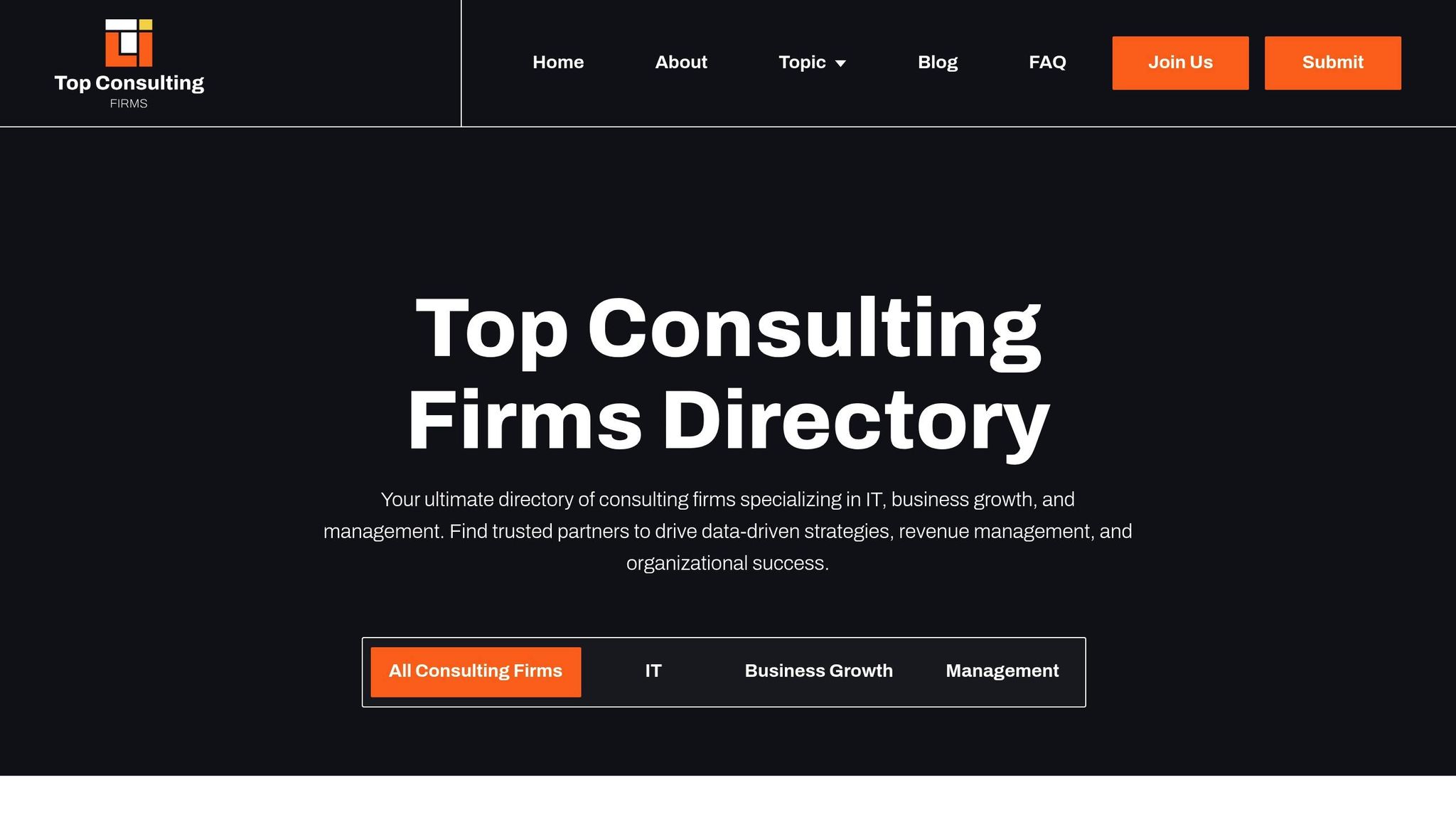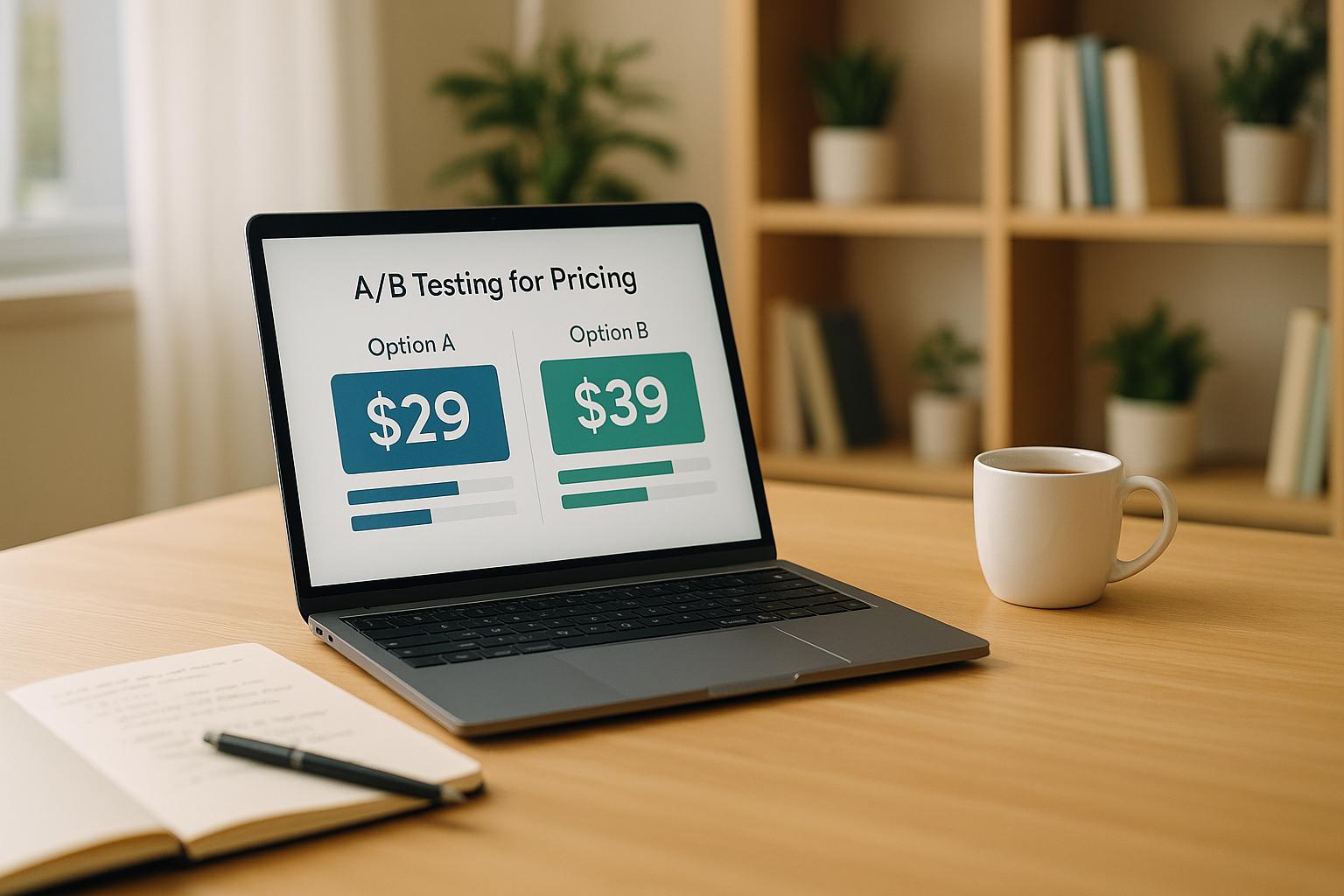Data-driven benchmarking is how consultants help businesses measure their performance against industry leaders, competitors, or best practices. By analyzing metrics like financial performance, customer satisfaction, and workforce productivity, companies can identify gaps, improve efficiency, and make informed decisions.
Key Takeaways:
- What it is: Comparing a company’s data to benchmarks using advanced analytics.
- Why it matters: Reveals performance gaps, sets realistic goals, and improves decision-making.
- Types: Competitive (vs. competitors), Functional (specific processes), Generic (common practices).
- Process: Define goals, collect data, analyze gaps, implement strategies, and track progress.
- Tools: AI, dashboards, and surveys simplify insights and forecasting.
This approach replaces guesswork with facts, helping businesses save money, improve efficiency, and stay competitive.
How Business Consultants Can Use AI to Research & Benchmark Any Industry
The Data-Driven Benchmarking Process
This process takes raw data and turns it into actionable insights that businesses can use to improve performance. By following a structured approach, consultants ensure that their recommendations are both meaningful and practical, helping organizations achieve measurable improvements.
Planning and Metrics Selection
The first step in successful benchmarking is setting clear SMART objectives. These objectives guide the entire effort, whether the goal is to boost operational efficiency, reduce costs, or gain a strategic edge.
Consultants work closely with clients to pinpoint areas needing improvement. Together, they select metrics that align with these goals and determine the most suitable type of benchmarking. For instance, if the focus is on cutting costs, the process might involve comparing production efficiency with industry leaders.
Metrics are chosen across various operational areas, including:
- Financial performance
- Service delivery
- Operational efficiency
- Business development
- Talent management
- Client impact
A deep understanding of the client’s industry and strategic goals ensures that the selected metrics are relevant and support the company’s overall direction. Establishing baseline measurements during this phase provides a starting point for comparison, setting the stage for meaningful analysis.
With objectives and metrics in place, the focus shifts to collecting and analyzing data.
Data Collection and Analysis
Once metrics are defined, consultants gather data from a range of sources, including internal systems, industry databases, public financial reports, market research, and, when necessary, surveys or interviews. This systematic approach ensures a comprehensive view of performance.
To make the data comparable, adjustments are made for factors like company size or regional cost differences. During analysis, advanced tools and statistical methods are used to uncover performance gaps and trends. Consultants look for significant deviations from industry benchmarks - both strengths and weaknesses - to understand what drives performance differences. They may also segment data by business model, company size, or operational characteristics for deeper insights.
Verification across multiple data sources ensures that findings are accurate and reflect genuine opportunities rather than short-term market shifts. These insights then guide the next phase: implementation.
Implementation and Continuous Improvement
The final step is turning insights into actionable strategies. Consultants collaborate with clients to prioritize opportunities based on their potential impact, resource needs, and alignment with strategic goals.
Specific action plans are developed, complete with timelines, resource allocation, and measurable success metrics. To ensure progress, monitoring tools like dashboards, regular review meetings, and milestone tracking are put in place.
Continuous improvement is key, as market dynamics and competition are always changing. To maintain an edge, periodic benchmarking updates are conducted, allowing businesses to track progress and uncover new areas for growth.
This phase often includes change management support, helping organizations adapt their processes, systems, and culture to sustain improvements. Through training, process documentation, and ongoing guidance, consultants aim to ensure that the changes are not just temporary fixes but lasting enhancements.
Tools and Technologies for Benchmarking
Today's consultants depend on advanced tools to turn raw data into meaningful insights. These technologies simplify complex analyses, reveal hidden trends, and present findings in a way that's easy to understand. They work hand-in-hand with established benchmarking processes, making data collection, analysis, and strategy development more efficient.
AI-Powered Benchmarking Tools
Artificial intelligence has reshaped the way benchmarking is done, offering the ability to process massive amounts of data at incredible speeds. Using machine learning, these tools detect patterns across industries, adjust for variables like company size, and account for market conditions.
One standout feature of AI tools is predictive benchmarking. For instance, if a manufacturing firm aims to cut production costs by 15%, AI can forecast how this might affect quality, delivery times, or customer satisfaction by analyzing similar cases. This kind of modeling helps businesses anticipate outcomes before making significant changes.
Another game-changer is natural language processing (NLP), which allows tools to analyze unstructured data like customer feedback, employee surveys, or industry reports. This goes beyond financial metrics, offering a broader understanding of trends - like shifts in customer sentiment or operational challenges that might not yet show up in formal reports.
AI platforms also specialize in anomaly detection, flagging unusual patterns in performance metrics. If a client’s numbers suddenly deviate from industry benchmarks, the system raises an alert, helping consultants identify potential problems - or opportunities - early on.
Data Visualization and Analytics Platforms
Data is only useful if it’s presented clearly. Modern visualization tools take complex datasets and turn them into interactive dashboards that highlight performance gaps and opportunities.
These platforms often include real-time performance scorecards, which compare a company’s metrics against competitors across various dimensions. Executives can zoom in from broad industry comparisons to specific operational details, pinpointing areas of strength or weakness.
Heat maps are another popular feature, showing performance variations across business units or regions. For example, a retailer could quickly spot differences in sales per square foot, customer satisfaction, or inventory turnover between stores.
Many platforms also offer scenario modeling, allowing consultants to demonstrate the potential impact of specific changes. For example, they can show how improving delivery times might affect customer satisfaction scores. This visual approach helps decision-makers see the value of proposed investments before committing resources.
Collaboration is another key feature. The best tools support shared dashboards, where stakeholders can add comments, track progress, and stay aligned on benchmarking goals.
Survey and Research Methods
While automated tools handle much of the data collection, some insights require direct input from people. Primary research is essential for understanding customer preferences, employee satisfaction, and operational hurdles.
One effective method is MaxDiff analysis, which identifies what customers value most. Instead of asking respondents to rate everything as important, this technique forces them to prioritize, revealing their true preferences. For example, a healthcare provider might use MaxDiff to determine whether patients care more about shorter wait times, lower costs, or better communication.
Choice modeling takes this a step further by simulating real-world decisions. It tests how changes in pricing, service levels, or product features could shift market share. This provides concrete benchmarks for making strategic choices.
Conjoint analysis breaks down products or services into individual components, measuring how each contributes to customer preferences. This helps businesses understand not just overall performance but the specific features that give them a competitive edge.
For operational benchmarking, qualitative methods like structured interviews and observational studies are invaluable. These approaches uncover best practices at top-performing organizations, shedding light on the processes behind impressive metrics - something raw data alone often can’t provide.
Modern digital survey platforms also enhance research, offering features like adaptive questioning. These systems adjust follow-up questions based on previous answers, making surveys more engaging and improving response rates. This leads to higher-quality data for benchmarking studies.
sbb-itb-97f6a47
Benefits of Data-Driven Benchmarking for Clients
Data-driven benchmarking isn't just about comparing performance metrics - it's about leveraging information to create meaningful change. When consultants use data-driven approaches, businesses gain insights that reshape how they operate, compete, and grow in their industries.
Better Decision-Making and Planning
Relying on data instead of intuition removes the guesswork from decision-making. With access to real-time, detailed information, leadership teams can clearly see how they measure up against competitors and pinpoint specific actions to improve.
Modern benchmarking tools go a step further by offering forecasting capabilities, allowing companies to align their resources with strategies that are proven to work. This proactive approach minimizes the risk of costly mistakes and builds confidence in critical business decisions.
Another major benefit is stakeholder alignment. When everyone - from marketing to operations to finance - works from the same data set, it’s easier to create unified strategies. This shared understanding not only speeds up implementation but also boosts results across the board.
Additionally, data-driven methods provide customized insights tailored to a business’s unique context, such as its size, location, or operating model. Instead of relying on broad industry averages, companies receive precise insights that help them set realistic goals and develop actionable plans.
The end result? Smarter decisions that lead to improved efficiency and cost savings.
Better Performance and Cost Savings
One of the most practical advantages of data-driven benchmarking is its ability to uncover areas for efficiency. By identifying the practices that set top performers apart, businesses can focus their efforts on initiatives that deliver the greatest return. This targeted approach ensures resources aren’t wasted on changes that won’t make a meaningful impact.
Cost-saving opportunities also become clear. Benchmarking often reveals areas where companies are overspending compared to industry leaders who achieve better results with fewer resources. These insights not only lead to immediate savings but also improve overall competitiveness.
Unlike traditional benchmarking, which offers a one-time snapshot, modern methods provide continuous monitoring. This ongoing tracking ensures that businesses stay on course and quickly address any drift from their goals.
Another key benefit is revenue optimization. Benchmarking data sheds light on how top companies price their products, structure services, and manage customer relationships. These insights help businesses refine their strategies to boost profitability without losing their competitive edge.
Data-Driven vs. Standard Benchmarking Methods
Comparing traditional benchmarking methods to data-driven approaches highlights why the latter delivers more impactful results. The differences touch on everything from speed and accuracy to cost and customization.
| Aspect | Standard Benchmarking | Data-Driven Benchmarking |
|---|---|---|
| Data Sources | Industry reports, surveys, public information | Real-time data feeds, AI analysis, comprehensive databases |
| Analysis Speed | Weeks to months | Hours to days |
| Customization | Generic industry comparisons | Tailored to specific business models and contexts |
| Accuracy | Based on aggregated, often outdated data | Current, granular, and verified information |
| Predictive Capability | Limited to historical trends | Forecasting capabilities |
| Update Frequency | Annual or quarterly | Continuous or on-demand |
| Cost Structure | High upfront costs for studies | Scalable pricing based on usage and complexity |
| Implementation Support | Static reports requiring interpretation | Interactive dashboards with actionable insights |
The real-time capabilities of data-driven benchmarking stand out as a game-changer. Businesses can adapt to market shifts immediately rather than waiting months for the next industry report. This agility is especially crucial in fast-paced industries where competitive advantages can quickly change.
Another standout feature is personalization. Traditional benchmarking often forces businesses to compare themselves to broad industry averages, which may not be relevant. Data-driven methods, on the other hand, allow for comparisons with peer groups that share similar characteristics, making the insights far more actionable.
Finally, the integration capabilities of modern benchmarking tools streamline operations. By connecting directly to a company’s business intelligence systems, these platforms eliminate the need for manual updates and ensure everyone is working with the most current information. This not only saves time but also reduces administrative burdens, allowing teams to focus on driving results.
How to Choose the Right Consulting Partner
Choosing the right consulting partner for data-driven benchmarking can make or break the value of your insights. The wrong partner might offer generic advice that doesn’t align with your business, while the right one delivers strategies that lead to real, measurable results. This decision builds on the data-driven insights discussed earlier, ensuring every recommendation aligns with your benchmarking goals.
Key Criteria for Selecting a Consultant
When evaluating potential consultants, focus on a few critical factors to ensure you’re making the right choice.
Industry expertise and technical skills are essential. A consultant who understands the specific challenges of your industry and uses advanced analytics tools can provide benchmarks that are both relevant and actionable. Look for firms with experience working with businesses of a similar size and complexity in your sector. This ensures their insights will be tailored to your needs, not just generic advice.
Top firms rely on cutting-edge tools like machine learning algorithms and real-time data platforms. When speaking with potential partners, ask about their data sources, the analytics tools they use, and how often their databases are updated.
A proven track record is another must-have. Ask for case studies or examples of measurable results they’ve delivered, such as cost savings, improved efficiency, or revenue growth. Consultants who can’t provide clear examples of their impact may not be the right fit.
Access to high-quality data is non-negotiable. Leading consultants often have partnerships with multiple data providers and access to proprietary databases that smaller firms might lack. This access ensures your benchmarks are accurate and meaningful.
Transparency in methodology is crucial for trust. A good consultant will walk you through their process, explaining their analytical methods and how they account for variables that could distort results. This openness builds confidence in their recommendations and ensures you’re aligned every step of the way.
If you’re unsure where to start, the Top Consulting Firms Directory is a great resource to narrow down your options quickly.
Using the Top Consulting Firms Directory

The Top Consulting Firms Directory simplifies the search for qualified consultants specializing in data-driven benchmarking. This curated list connects businesses with firms that excel in areas like data analytics, digital transformation, and strategic management.
Whether your focus is on increasing revenue, improving operational efficiency, or expanding into new markets, the directory helps you find firms with a history of success in these areas. Every listed firm has undergone a quality check, ensuring their expertise and client satisfaction are verified.
The directory also provides detailed information about each firm’s services and specializations, helping you identify consultants who align with your specific needs. For example, you can see which firms focus on particular industries, company sizes, or challenges.
Client reviews and case studies included in the directory give additional insight into the experiences of other businesses. These real-world examples help you make informed decisions about which consultants to contact.
The Importance of Confidentiality and Customization
For benchmarking to deliver actionable insights, confidentiality and a tailored approach are essential.
Protecting your data should be a top priority. Consultants must have strict confidentiality protocols, secure data transmission methods, and experience handling proprietary information. Be sure to ask about their data retention policies and how they safeguard sensitive business details from unauthorized access.
Tailored insights make all the difference. The best consultants don’t rely on broad industry averages. Instead, they focus on peer groups with characteristics similar to yours, such as company size, geographic location, business model, or market position. This ensures the benchmarks are relevant and actionable.
Choosing the right engagement model is equally important. Some firms offer project-based services for specific benchmarking initiatives, while others provide ongoing partnerships with continuous updates. Select a model that fits your budget, timeline, and long-term goals.
Finally, consider cultural fit and scalability. A consultant who listens to your concerns and asks thoughtful questions is more likely to deliver successful outcomes. And as your needs evolve, a partner who can scale their services ensures you won’t have to start over with someone new. These factors contribute to a smoother, more productive collaboration.
Conclusion
Data-driven benchmarking transforms decision-making by replacing guesswork with solid evidence. This approach not only streamlines operations but also strengthens relationships with clients.
Key Takeaways
At its core, data-driven benchmarking is about converting raw data into actionable insights. Organizations that embrace this practice report decision-making improvements at three times the rate of their peers.
The most impactful benchmarking efforts prioritize smart data selection over simply collecting massive datasets. Randy Bean, CEO of NewVantage Partners, puts it best:
"Big data is already being used to improve operational efficiency. And the ability to make informed decisions based on the very latest up-to-the-moment information is rapidly becoming the mainstream norm."
These efforts deliver real results. For example, 49% of companies that used data to cut expenses saw measurable benefits. A standout case is Starbucks, which collaborates with location-analytics firms to analyze demographics and traffic patterns. This data-driven approach has significantly improved their site selection and real estate decisions.
The ongoing nature of data-driven benchmarking ensures it’s not just a one-time benefit. Continuous monitoring helps businesses stay agile, adapt to market shifts, and maintain a competitive edge.
Thanks to advances in technology, tools like AI-powered analytics, real-time data platforms, and advanced visualization software are now accessible to businesses of all sizes. However, success depends on choosing the right metrics, testing hypotheses rigorously, and tracking results carefully.
These practices set the stage for well-informed, strategic action.
Next Steps for Businesses
To unlock the full potential of data-driven benchmarking, start by identifying performance gaps and selecting the metrics that matter most for your industry and goals. Whether you’re aiming for operational efficiency, revenue growth, or market expansion, the right consulting partner can turn data into a strategic advantage.
Finding the right consultant doesn’t have to be daunting. The Top Consulting Firms Directory simplifies the process by connecting you with vetted experts in data analytics, digital transformation, and strategic management. These professionals have a proven ability to turn benchmarking insights into tangible business results.
As you evaluate potential consultants, focus on those who can address your specific challenges. Look for firms that prioritize data security and tailor their analysis to your unique market position. This ensures that your proprietary information remains protected while delivering insights that align with your business objectives.
Ready to get started? Explore the Top Consulting Firms Directory to find the expertise you need. With the right partner and a clear project scope, your business can achieve the measurable improvements that define highly data-driven organizations. This is your opportunity to move from insight to action and build a foundation for sustained success.
FAQs
How do consultants choose the right type of benchmarking for a client’s needs?
Consultants determine the best type of benchmarking by thoroughly assessing the client’s goals, challenges, and industry context. They look at whether the focus is on enhancing performance metrics, examining process efficiency, or uncovering strategic insights.
Here are the three most common types of benchmarking:
- Performance benchmarking: This involves comparing key metrics against industry standards to measure how a company stacks up.
- Process benchmarking: Focused on analyzing and refining specific workflows to boost efficiency.
- Competitive benchmarking: Centers on studying competitors to pinpoint areas for improvement or new opportunities.
The choice of benchmarking method hinges on the client’s objectives, the data available, and the outcomes they aim to achieve. This ensures the approach is tailored to their specific needs and priorities.
What challenges do businesses face with data-driven benchmarking, and how can they address them?
Businesses often face hurdles when trying to implement data-driven benchmarking. Common issues include inaccurate or incomplete data, limited access to trustworthy sources, challenges in making sense of complex analytics, and pushback from within the organization. These setbacks can significantly impact the success of benchmarking initiatives.
To address these problems, companies should prioritize improving data quality by implementing robust validation processes and encouraging collaboration among stakeholders. Using intuitive analytics tools and scalable cloud platforms can make data easier to interpret and more accessible. Furthermore, creating a workplace culture that values ongoing improvement and educating teams on the advantages of benchmarking can help ease resistance, paving the way for smoother adoption and better outcomes.
How can businesses make sure their benchmarking data is accurate and meaningful?
To make benchmarking data reliable and useful, businesses should begin with detailed data audits. These audits help uncover gaps, errors, or inconsistencies that might skew results. Additionally, it's crucial to rely on trustworthy and up-to-date sources to ensure the data aligns with current market trends and industry norms.
Keeping datasets updated regularly, leveraging automated validation tools, and implementing strong quality control processes can significantly improve data accuracy. By following these practices, businesses can uncover insights that genuinely highlight performance opportunities and support smarter decision-making.


